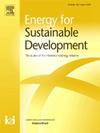大规模采用浮动太阳能光伏技术:以印度为例
IF 4.9
2区 工程技术
Q2 ENERGY & FUELS
引用次数: 0
摘要
为了实现净零目标,世界各国正致力于扩大可再生能源的规模。虽然印度在太阳能发电能力方面取得了长足的进步,但浮动太阳能光伏(FPV)的采用仍然有限。尽管有明显的好处,但扩大FPV技术的规模也面临着一些挑战,包括确定适合FPV实施的储层,以及高于地面太阳能光伏的成本。本研究解决了这些挑战,并为大规模采用该技术提供了技术、财务和其他相关方面的见解。为了解决FPV采用的技术问题,本研究基于印度特定的必要和有利条件,开发了一种新的选择框架,以选择适合FPV部署的油藏。将该框架应用于印度130个油藏的综合数据集,确定了17个油藏。建立了储层排序框架,对已确定的17个储层进行了评价和排序。分析显示,虽然Almatti水库是最合适的水库,但马哈拉施特拉邦的水库数量最多,其次是奥里萨邦。为了解决采用FPV的财务问题,我们进行了基于平均成本的经济评估,发现FPV系统的LCOE范围为3.16-3.80印度卢比/千瓦时,远低于全国平均水平。在17个水库中,Tungabhadra水库的FPV LCOE最小,为3.16 INR /kWh。为了降低FPV相对于-à-vis地面光伏系统的LCOE,我们建议采取利率补贴、资本支出补贴和发电激励等政策。该研究的框架和见解可能对希望扩大FPV技术规模的FPV潜力高的国家有用。本文章由计算机程序翻译,如有差异,请以英文原文为准。
At-scale adoption of floating solar PV technology: The case of India
To achieve net zero targets, countries worldwide are focusing on scaling renewable energy. While India has made substantial strides in solar power capacity, the adoption of Floating Solar PV (FPV) remains limited. Despite apparent benefits, scaling FPV technologies presents several challenges including identifying suitable reservoirs for FPV implementation, and higher than ground-based solar PV costs. This study addresses these challenges and provides insights into the technological, financial and other related aspects for its at-scale adoption. To address the technological aspect of FPV adoption, this study develops a novel selection framework based on specific necessary and conducive conditions to select reservoirs suitable for FPV deployment in India. Applying this framework to a comprehensive dataset of 130 reservoirs in India, 17 reservoirs were identified. We also developed a reservoir ranking framework, to evaluate and rank the 17 identified reservoirs. The analysis revealed that while Almatti reservoir is the most suitable reservoir, Maharashtra emerged as the state with the maximum number of reservoirs, followed by Odisha. To address the financial aspect of FPV adoption, we carried out a levelized cost based economic assessment and found that LCOE for FPV systems ranges from INR 3.16–3.80/kWh which is much lower than the national average. Among the 17 reservoirs, FPV at the Tungabhadra reservoir has the least LCOE of INR 3.16/kWh. For reducing LCOE of FPV vis-à-vis ground-based PV systems, we suggest policies such as interest rate subsidy, capital expenditure subsidy and Generation Based Incentives. The study's framework and insights could be useful for countries with high FPV potential looking to scale up FPV technology.
求助全文
通过发布文献求助,成功后即可免费获取论文全文。
去求助
来源期刊

Energy for Sustainable Development
ENERGY & FUELS-ENERGY & FUELS
CiteScore
8.10
自引率
9.10%
发文量
187
审稿时长
6-12 weeks
期刊介绍:
Published on behalf of the International Energy Initiative, Energy for Sustainable Development is the journal for decision makers, managers, consultants, policy makers, planners and researchers in both government and non-government organizations. It publishes original research and reviews about energy in developing countries, sustainable development, energy resources, technologies, policies and interactions.
 求助内容:
求助内容: 应助结果提醒方式:
应助结果提醒方式:


